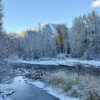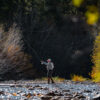Well, Mr. Traver may be right, but were going to keep trying anyway! Local rivers continue to dole out hatches and fishable water as the rivers come into shape ever so slowly. There have been two significant drops in water levels, one on the 9th of July and one on the 15th of July. This drop will provide more fishable water in the coming week and help bring high country rivers to a much more fishable flow. Our namesake, Silver Creek is about to begin its “second season” as water levels and insects begin to change.
Silver Creek
Last month, the caddis fly, which is normally a “secondary” insect on Silver Creek, took center stage as the best hatch on the river. Baetis and P.M.D. activity was strong and the Baetis continues to be, but that is normal. The Brown Drake was spread out over a month instead of a few days and generally speaking, the river has been tough to predict, but in any event it keeps producing outstanding fishing opportunities.
This months “secondary” insect is the Damsel Fly, and these blue bodied beauties are coming out in force and the fish are keying on them. This is normally an August occurrence in these numbers, but this year they are earlier and numerous and beginning to take center stage. To be successful with Damsel Flies, treat them as you would a hopper. In other words, stay on the move. The Damsel Fly is not a fly that you show repeatedly to a rising fish that is eating mayflies. It is a fly that you want to show to numbers of fish. This means float tubes are a big key, allowing you easy access to long stretches of water. The best place to target this fly is immediately downstream of any floating weed mass. Fish will collect in these spots to take the dying damsels that float off the back side of the weeds. While floating you can also blind fish damsel flies along the bank. The longer your drift, the better your chances. Do your best to float along at the same speed as your fly. If there are other anglers in the area this is probably a tactic best left for solitary days on the water. Don’t use 6X on Damsel Flies, you will lose your fly and decorate a fish. Try 4X with a little bit of Orvis Mud or Henry’s Sinket to hide your tippet in the surface film.
Callibaetis is another insect coming on stronger in the afternoon heat. Look for these insects in the slowest stretches of the river, and in the sloughs. Fish can get aggressive toward the bigger Callibaetis, especially if the morning hatches and spinner falls of other insects were meager.
Tricos are beginning to happen and although the activity is short lived, this morning rise will increase on a daily basis and soon be “THE” event on the Creek. Caddis activity is beginning to wane, but is still strong during low light periods.
Big Wood River
A virtual smorgasbord of insects cover the Wood these days. There is definitely a morning bite happening as well as a late afternoon bite. In between bites plenty of fish can be tempted to the top with big dry flies. There is a large amount of insect activity and in many instances anglers will see as many as 5 to 10 different kinds of insects all at once. Small yellow and pink mayflies seem to best hold the fish’s attention during the rise. Several sizes of stoneflies are prolific as are crane flies and cicadas. The Green Drake is still hatching in good numbers and can be the best action of the day if an angler is in the right spot.
With the hot days starting to stack up, expect the Wood to become a morning / evening fishery with the next big event being the evening Caddis. The Caddis nymphs are mature and on the move, so anglers willing to stay out until dark will soon see some incredible low light fishing.
Lost River
The lost below the dam in Mackay is still pumping along and is in fact higher than last week. Serious wading skills are a must this week if you want to nymph the seams and buckets. There is some surface activity in a few areas but many of these places can be hard to reach. This should be an unreal fall fishery this year, but for now we can only wait for the waters to drop.
Copper Basin and Area Waters
The upper end of the Lost River system keeps pumping large volumes of water downstream, but this heavy flow has been cut way back in the last 48 hours. Not to long ago this area was considered primarily a fall fishery, then with the drought, we all got used to low flows and great summer fun in this area. This year we’re back to higher flows and headwater areas are fishing o.k.; while down stream, on the East Fork of the Lost, wading and flows still make the fishing pretty tough. With the Wood dropping a lot recently, we can expect the same over the pass and these waters should really turn on this week. Throw big dry flies or general attractor patterns if you go.
Little Wood River
The Little Wood is fishing o.k. with no reports of huge fish, but also no reports of crowds or other anglers. Look for fish to hit attractor patterns and small bead head nymphs. If you head for the desert stretches try to get there at the crack of dawn to beat the heat. Once the temperatures begin to rise, keep an eye out for rattlesnakes. By late morning it’s probably time to head for the shade of the Big Wood anyway.
Warm Springs, Trail Creek, North Fork of the Big Wood, Lake Creek Lake, Penny and Dollar Lakes
All are stocked and fishing pretty well. Try standard dry flies like Parachute Adams and elk hair caddis. For kids that are used to fishing these areas with worms, try fishing a fly bubble on a spin rod with a small dry fly attached. The guys in the shop can show you how to rig this. All the ease of the spin rod, but with the excitement of the surface strike! The kids will love it.
WATER CONDITIONS
Basin Precip. Averages
Salmon – 79%
Big Wood – 91%
Little Wood – 114%
Big Lost – 105%
Henry’s Fork – 87%



